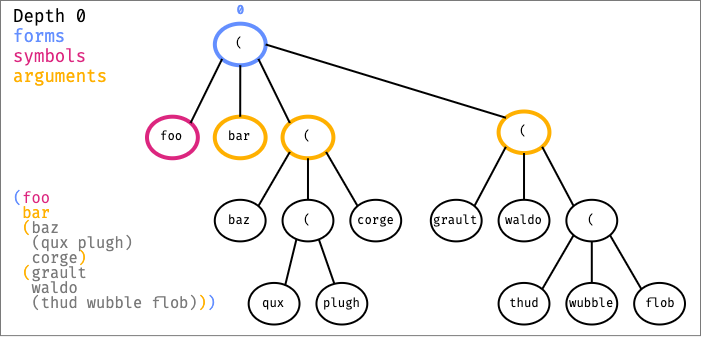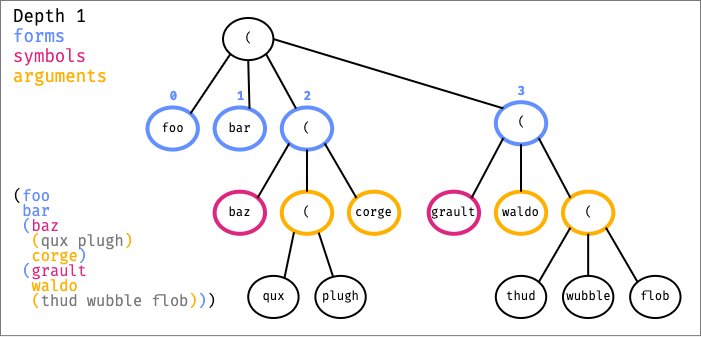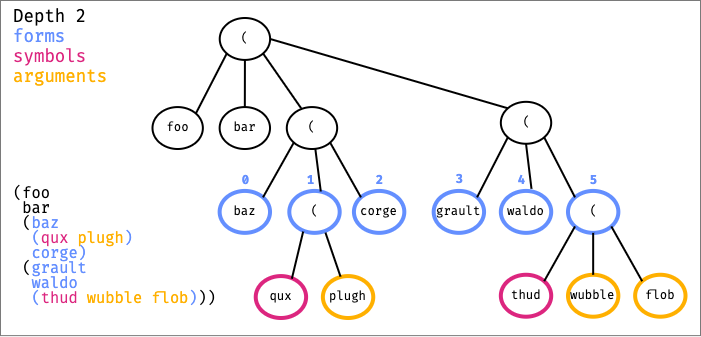cljfmt is a tool for formatting Clojure code idiomatically.
It can turn something like this:
( let [x 3
y 4]
(+ (* x x
)(* y y)
))Into nicely formatted Clojure code like this:
(let [x 3
y 4]
(+ (* x x) (* y y)))However, it is not the goal of cljfmt to provide a canonical format.
The easiest way to get started with cljfmt is to add the lein-cljfmt plugin to your Leiningen project map:
:plugins [[lein-cljfmt "0.9.2"]]cljfmt has tested on Leiningen 2.5, but may not work on older versions, particularly versions prior to Leiningen 2.4.
To check the formatting of your source files, use:
lein cljfmt check
If the formatting of any source file is incorrect, a diff will be supplied showing the problem, and what cljfmt thinks it should be.
If you want to check only a specific file, or several specific files, you can do that, too:
lein cljfmt check src/foo/core.clj
Once you've identified formatting issues, you can choose to ignore them, fix them manually, or let cljfmt fix them with:
lein cljfmt fix
As with the check task, you can choose to fix a specific file:
lein cljfmt fix src/foo/core.clj
It is also possible to use the clojure command-line tool to check your project's files:
clojure -Sdeps '{:deps {cljfmt {:mvn/version "0.9.2"}}}' \
-m cljfmt.main [check|fix]Customizing the indentation rules is possible by supplying a custom
indentation file. For example, indentation.clj:
{org.me/foo [[:inner 0]]}You can then specify this file when running cljfmt:
clojure -Sdeps '{:deps {cljfmt {:mvn/version "0.9.2"}}}' \
-m cljfmt.main check \
--indents indentation.clj- vim-cljfmt
- CIDER 0.9+
- Calva (VS Code)
- clojureVSCode (VS Code)
You can configure lein-cljfmt by adding a :cljfmt map to your
project:
:cljfmt {}You can configure cljfmt by placing a .cljfmt.edn or .cljfmt.clj
file in the directory where you run the command, or any parent
directory. The first file in the hierarchy will be used, files in
higher up parent directories are ignored.
cljfmt has several different formatting rules, and these can be selectively enabled or disabled:
-
:indentation?- true if cljfmt should correct the indentation of your code. Defaults to true. -
:remove-surrounding-whitespace?- true if cljfmt should remove whitespace surrounding inner forms. This will convert( foo )to(foo). Defaults to true. -
:remove-trailing-whitespace?- true if cljfmt should remove trailing whitespace in lines. This will convert(foo) \nto(foo)\n. Defaults to true. -
:insert-missing-whitespace?- true if cljfmt should insert whitespace missing from between elements. This will convert(foo(bar))to(foo (bar)). Defaults to true. -
:remove-consecutive-blank-lines?- true if cljfmt should collapse consecutive blank lines. This will convert(foo)\n\n\n(bar)to(foo)\n\n(bar). Defaults to true. -
:remove-multiple-non-indenting-spaces?- true if cljfmt should remove multiple non indenting spaces. This will convert{:a 1 :b 2}to{:a 1 :b 2}. Defaults to false. -
:split-keypairs-over-multiple-lines?- true if cljfmt should break hashmaps onto multiple lines. This will convert{:a 1 :b 2}to{:a 1\n:b 2}. Defaults to false. -
:sort-ns-references?- true if cljfmt should alphanumerically sort the requires, imports and other references in thensforms at the top of your namespaces. Defaults to false.
You can also configure the behavior of cljfmt:
-
:paths- determines which directories to include in the scan. Arguments tolein checktake precedence. If neither:pathsnor command line arguments are given, cljfmt uses the lein project's:source-pathsand:test-paths. -
:file-pattern- determines which files to scan,#”\.clj[csx]?$”by default. -
:indents- a map of var symbols to indentation rules, i.e.{symbol [& rules]}. See the next section for a detailed explanation.Unqualified symbols in the indents map will apply to any symbol with a matching "name" - so
foowould apply to bothorg.me/fooandcom.them/foo. If you want finer-grained control, you can use a fully qualified symbol in the indents map to configure indentation that applies only toorg.me/foo::cljfmt {:indents {org.me/foo [[:inner 0]]}}Configured this way,
org.me/foowill indent differently fromcom.them/foo.Note that
cljfmtcurrently doesn't resolve symbols brought into a namespace using:referor:use- they can only be controlled by an unqualified indent rule.As with Leiningen profiles, you can add metadata hints. If you want to override all existing indents, instead of just supplying new indents that are merged with the defaults, you can use the
:replacehint::cljfmt {:indents ^:replace {#".*" [[:inner 0]]}} -
:alias-map- a map of namespace alias strings to fully qualified namespace names. This option is unnecessary in almost all cases, becausecljfmtcan compute the alias map from annsdeclaration.However, it can't do that when used as a CLJS library, or when indenting something with no
nsdeclaration like an EDN file. Even in those situations, you only need this option when using indentation rules that rely on the fully qualified symbol name.If you definitely need to configure this, it should look like this:
:cljfmt {:indents {org.me/foo [[:inner 0]]} :alias-map {"me" "org.me"}}
When we talk about how rules affect indentation of source code, we
refer to (foo arg1 arg2...
argn) as a form, foo as a form symbol, and
arg1 arg2 ... argn as
form arguments.
The default indentation rules are encoded here.
Rules affect indentation of form arguments. A form argument is eligible for indentation only when it is the first element on a line.
An indentation rule specifies an indentation type and indentation type arguments. One or more rules can be applied to a form symbol.
Indentation types are:
-
:inner- two character indentation applied to form arguments at a depth relative to a form symbol -
:block- first argument aligned indentation applied to form arguments at form depth 0 for a symbol
A rule for depth n affects indentation of form arguments relative to form symbol at depth n.
Form depth is the nested depth of any element within the form.
A contrived example will help to explain depth:
(foo
bar
(baz
(qux plugh)
corge)
(grault
waldo
(thud wubble flob)))If we look at the example code as a tree, we can visualize the effect
of different form depths relative to foo:
In the absence of indentation rules:
(foo bar (foo bar
baz == formats to => baz
bang) bang)(foo (foo
bar == formats to => bar
bang) bang)The :inner rule applies an indentation of two spaces to all eligible
form arguments of forms at a given form depth. It has 2 rule type
arguments:
-
form-depth- apply inner indentation within forms at this depth -
limit-to-form-index- optionally limit indentation formatting to a single form, by default formatting is applied to all forms atform-depth
Indent rule:
{foo [[:inner 0]]}Will indent all arguments for symbol foo at depth 0 by two spaces:
(foo bar (foo bar
baz == formats to => baz
bang) bang)Indent rule:
{foo [[:inner 1]]}Results in :inner indenting form arguments at depth 1. Form
(bang...) is at depth 1 so its arguments are affected:
(foo bar (foo bar
baz baz
(bang == formats to => (bang
quz quz
qoz)) qoz))Because no rule was specified for depth 0, default indentation is
applied to bar baz and (bang...).
Sometimes it is useful to limit :inner indentation to one, rather
than all, forms at the specified depth. For example, we'd like letfn
to use inner indentation only in its binding vector.
Let's look at letfn example in the absence of any indentation rules:
(letfn [(double [x]
(* x 2))] ;; want inner indentation here
(let [y (double 2)
z (double 3)]
(println y
z))) ;; but not hereApplying the rule:
{letfn [[:inner 2]]}Brings in the letfn function body to where we want it by affecting
form (double [x]...):
(letfn [(double [x]
(* x 2))] ;; want inner indentation here
(let [y (double 2)
z (double 3)]
(println y
z))) ;; but not hereBut also affects all other forms at depth 2. In this case,
(println...) indentation is affected in an undesirable way. To limit
formatting to (double [x]...), the 0th form at depth 2, the
limit-to-form-index rule type argument is added:
{letfn [[:inner 2 0]]}... giving us:
(letfn [(double [x]
(* x 2))] ;; want inner indentation here
(let [y (double 2)
z (double 3)]
(println y
z))) ;; but not hereRemember that when calculating limit-to-form-index, all forms at the
specified depth are included, even self-evaluating ones. Given:
(foo a b c
(e f
g)
(h i
j))To affect inner indentation within form (e...) only, we use a rule
of:
{foo [[:inner 1 3]]}Which results in:
(foo a b c
(e f
g)
(h i
j))Because (e...) is the 4th (index 3) at form depth 1.
The :block rule works like the :inner rule under some
circumstances, and like a normal list form under others. It takes one
argument:
line-threshold-index- if the argument at this index starts a new line, all following lines will be indented by a constant 2 spaces. Any other lines are indented normally.
For example:
{foo [[:block 0]]}If the argument at index 0 (the first argument) does not start a new line, the form is indented as normal:
(foo bar (foo bar
baz == formats to => baz
bang) bang)If it does, the lines are indented with a constant 2 spaces:
(foo (foo
bar == formats to => bar
baz baz
bang) bang)To give another example
{foo [[:block 1]]}This time we're looking at the argument at index 1 (the second argument). If it starts a new line, the indent is constant:
(foo bar (foo bar
baz == formats to => baz
bang) bang)But if it does not, start a new line, normal indentation rules are used instead:
(foo bar baz == formats to => (foo bar baz
bang) bang)Any lines before the threshold are always indented normally:
(foo (foo
bar bar
baz == formats to => baz
bang) bang)Multiple rules can be specified. Picking up from our previous letfn
example, the rule:
{letfn [[:inner 2 0]]}Gave us:
(letfn [(double [x]
(* x 2))] ;; want inner indentation here
(let [y (double 2)
z (double 3)]
(println y
z))) ;; but not hereAdding a :block rule:
{letfn [[:block 1][:inner 2 0]]}Matches the current default rule for letfn and
results in indenting the (let... to where we want it:
(letfn [(double [x]
(* x 2))] ;; want inner indentation here
(let [y (double 2)
z (double 3)]
(println y
z))) ;; but not hereIn this case, single form argument [(double...)] does not break the
line-arg-count-threshold of 1 and we therefore get inner
indentation for form argument (let...).
Copyright © 2022 James Reeves
Distributed under the Eclipse Public License either version 1.0 or (at your option) any later version.


